Discover Keen on Yoga Podcast
Keen on Yoga Podcast

Keen on Yoga Podcast
Author: Keen on Yoga Podcast
Subscribed: 149Played: 7,220Subscribe
Share
© All rights reserved
Description
Adam Keen engages in a deep level of discussion with Ashtanga yoga teachers as well as others involved in inquiry, wellness, diet, or simply people he finds interesting.
The in-depth discussions and honest conversations are often surprising. Prepare to have your thoughts expanded.
If you enjoy the podcast and would like to support us you can do so by liking, sharing, rating and donating at https://keenonyoga.com/donate/
The in-depth discussions and honest conversations are often surprising. Prepare to have your thoughts expanded.
If you enjoy the podcast and would like to support us you can do so by liking, sharing, rating and donating at https://keenonyoga.com/donate/
239 Episodes
Reverse
Ep 243 Adam Keen – My Ashtanga Teaching Manifesto Adam addresses the theme of abuse in Ashtanga yoga in light of more recent allegations. He explores the contrasting archetypes of teachers in the context of Ashtanga yoga, focusing on the strict adherence to tradition and the implications for student progression. Finally he lays out his personal Ashtanga teaching code of conduct and what students can expect when they come to a class, retreat, course or workshop with him. www.keenonyoga.com | @adam_keen_ashtanga LISTEN Apple podcast: https://podcasts.apple.com/us/podcast/keen-on-yoga-podcast/id1509303411 Spotify: https://open.spotify.com/show/5iM9lcw52JskHUZ2eFvVxN WATCH https://www.youtube.com/@keenonyoga SUPPORT Subscribe, like and share our videos Buy us a coffee: https://www.buymeacoffee.com/infoRf Patrons €10 per month: https://www.keenonyoga.com/patrons/ FOLLOW Website: www.keenonyoga.com Instagram: @keen_on_yoga | @adam_keen_ashtanga Linktree: https://linktr.ee/Keenonyoga Key Points · A strict teacher is often seen as a good teacher. · Traditional methods can create deep fault lines in education. · Commitment to the Ashtanga method is paramount for some teachers. · Teachers who shout at students may be deeply committed to tradition. · The purity of the Ashtanga method is a significant focus for some instructors. · Sacrifice is often required to achieve advanced levels in yoga. · The number of times a teacher has been to Mysore can indicate their commitment. · Respect for traditional methods can lead to rigid teaching styles. · Student progression may be hindered by strict adherence to perfection. · The balance between tradition and flexibility is crucial in teaching.
Elizabeth Kadetsky discusses her book 'First There Is A Mountain', detailing her experiences with Iyengar Yoga and the cultural dynamics surrounding it. She reflects on her journey to writing the book, her experiences in India, and the complexities of dietary practices within the yoga community. The discussion also touches on the historical context of Hindu nationalism, Iyengar's legacy, and the evolution of yoga practices over time. Kadetsky shares her insights on the nuances of yoga culture, the impact of her research, and her current approach to yoga. www.elizabethkadetsky.com | @ekadetsky LISTEN Apple podcast: https://podcasts.apple.com/us/podcast/keen-on-yoga-podcast/id1509303411 Spotify: https://open.spotify.com/show/5iM9lcw52JskHUZ2eFvVxN WATCH https://www.youtube.com/@keenonyoga SUPPORT Subscribe, like and share our videos Buy us a coffee: https://www.buymeacoffee.com/infoRf Patrons €10 per month: https://www.keenonyoga.com/patrons/ FOLLOW Website: www.keenonyoga.com Instagram: @keen_on_yoga | @adam_keen_ashtanga Linktree: https://linktr.ee/Keenonyoga Key Points · Elizabeth Kadetsky is a writer and professor at Penn State. · Her book 'First There Is A Mountain' was published in 2004. · Kadetsky's first trip to India was in 1997, leading to her research on Iyengar Yoga. · Iyengar Yoga emphasizes alignment and the use of props. · Dietary practices in yoga can reflect cultural and communal identities. · Kadetsky experienced cultural shock when practicing yoga in India compared to the West. · Iyengar's influence on yoga is significant but complex, involving historical and cultural dynamics. · The rise of Hindu nationalism has impacted the perception of yoga in India. · Kadetsky sees her book as a reflection of its time, capturing a specific moment in yoga history. · Her current yoga practice focuses more on meditation and breath rather than strict physical exercise.
Ep 241 Adam Keen – Healing Through Touch in Yoga Adam explores the complex and evolving role of touch in yoga practice. He discusses the historical context of touch in yoga, the healing potential of positive touch, and the challenges of safeguarding both students and teachers in a modern environment where boundaries have shifted. Keen emphasizes the importance of understanding good touch versus bad touch, advocating for a respectful and sensitive approach to physical interaction in yoga classes. He concludes with a call for thoughtful engagement with touch, recognizing its significance while also acknowledging the risks involved. www.keenonyoga.com | @adam_keen_ashtanga LISTEN Apple podcast: https://podcasts.apple.com/us/podcast/keen-on-yoga-podcast/id1509303411 Spotify: https://open.spotify.com/show/5iM9lcw52JskHUZ2eFvVxN WATCH https://www.youtube.com/@keenonyoga SUPPORT Subscribe, like and share our videos Buy us a coffee: https://www.buymeacoffee.com/infoRf Patrons €10 per month: https://www.keenonyoga.com/patrons/ FOLLOW Website: www.keenonyoga.com Instagram: @keen_on_yoga | @adam_keen_ashtanga Linktree: https://linktr.ee/Keenonyoga Key Points · Touch in yoga has evolved significantly over the decades. · Modern boundaries around touch have made it a contentious issue. · Positive touch can aid in healing from past negative experiences. · Consent cards and verbal agreements have limitations. · Good touch should feel affirming and supportive, not corrective. · Teachers must navigate touch with sensitivity and respect. · Physical adjustments can sometimes lead to injury or discomfort. · Building a relationship with students is essential before using touch. · Feedback mechanisms are crucial for ensuring safe touch practices. · Touch should enhance the yoga experience, not detract from it.
Ep 240 Tias Little – Yoga of the Subtle Body Adam speaks with Tias Little about the intricate relationship between yoga, anatomy, and the subtle body. Tias shares his extensive experience in yoga and meditation, discussing the importance of understanding the physical and energetic anatomy of the body. They explore various topics including the significance of the feet, the midline, bandhas, the psoas and diaphragm connection, the adrenal system, and the role of the heart in feeling. Tias emphasizes the need for humility in practice and the importance of fluid dynamics for longevity, ultimately leading to a deeper understanding of Samadhi and the journey inward. www.prajnayoga.com | @prajnayoga Book: Yoga of the Subtle Body: A Guide to the Physical and Energetic Anatomy of Yoga YOUTUBE https://www.youtube.com/@keenonyoga SUPPORT Subscribe, like and share our videos Buy us a coffee: https://www.buymeacoffee.com/infoRf Patrons €10 per month: https://www.keenonyoga.com/patrons/ FOLLOW Website: www.keenonyoga.com Instagram: @keen_on_yoga | @adam_keen_ashtanga Linktree: https://linktr.ee/Keenonyoga Key Points · The subtle body is a crucial aspect of yoga practice. · Understanding anatomy enhances the practice of yoga. · The feet serve as the foundation for the entire body. · The midline connects the ground to the sky, embodying balance. · Bandhas are about engagement and release, not just holding. · The psoas and diaphragm are interconnected in movement and breath. · The adrenal system plays a significant role in our energy levels. · Cultural reflections on yoga can inform our practice. · The sacrum is central to many yoga postures and movements. · Fluid dynamics in the body are essential for health and longevity.
Carolyn Williams, a science journalist and author speaks about the intricate connections between the mind and body, particularly focusing on interoception, the gut-brain axis, and the role of movement in mental health. They explore how our internal body signals influence our emotions, the importance of the vagus nerve, and the impact of hypermobility on anxiety. Carolyn shares insights from her research and personal experiences, emphasizing the need for daily movement and the potential for creativity through physical activity. The discussion highlights the evolving understanding of these concepts in both scientific and cultural contexts. www.carolinewilliams.net | @carolinewilliams_science YOUTUBE https://www.youtube.com/@keenonyoga SUPPORT Subscribe, like and share our videos Buy us a coffee: https://www.buymeacoffee.com/infoRf Patrons €10 per month: https://www.keenonyoga.com/patrons/ FOLLOW Website: www.keenonyoga.com Instagram: @keen_on_yoga | @adam_keen_ashtanga Linktree: https://linktr.ee/Keenonyoga Key Points · The mind and body are interconnected, influencing each other constantly. · Interoception is the awareness of internal body signals and is crucial for emotional regulation. · Experiments show that expectations can alter physical sensations, impacting mental health. · The gut plays a significant role in our overall health and emotional well-being. · The vagus nerve is more complex than previously thought, with many sensory functions. · Hostage negotiators use their sensitivity to body signals to make decisions in high-pressure situations. · Movement is essential for mental health and can enhance creativity. · Hypermobility can lead to anxiety due to physiological responses to movement. · Strength training can improve self-efficacy and confidence in one's body. · Daily movement snacks can enhance overall well-being and prevent sedentary behavior.
Adam explores the legacy of Krishnamacharya, the father of modern yoga, and the impact of his teachings on contemporary practices. He discusses the influence of Krishnamacharya's students, Pattabhi Jois and BKS Iyengar, and how their interpretations differ from his original teachings. Keen emphasizes the importance of understanding the context in which Krishnamacharya taught and how his methods evolved over time. He also delves into the innovations in yoga postures and the myth surrounding the Yoga Karunta, highlighting the multifaceted nature of Krishnamacharya's legacy and its implications for modern yoga practice. www.keenonyoga.com | @adam_keen_ashtanga PODCAST Apple podcast: https://podcasts.apple.com/us/podcast/keen-on-yoga-podcast/id1509303411 Spotify: https://open.spotify.com/show/5iM9lcw52JskHUZ2eFvVxN YOUTUBE https://www.youtube.com/@keenonyoga SUPPORT Subscribe, like and share our videos Buy us a coffee: https://www.buymeacoffee.com/infoRf Patrons €10 per month: https://www.keenonyoga.com/patrons/ FOLLOW Website: www.keenonyoga.com Instagram: @keen_on_yoga | @adam_keen_ashtanga Linktree: https://linktr.ee/Keenonyoga Key Points · Krishnamacharya is considered the father of modern yoga. · His teachings were popularized by his students, Pattabhi Jois and BKS Iyengar. · Krishnamacharya's teaching methods evolved significantly over his lifetime. · The context of his teachings was influenced by the political climate of India. · His legacy is often associated with performative yoga demonstrations. · Krishnamacharya's later teachings focused on therapeutic practices. · The myth of Yoga Korunta serves to authenticate modern yoga. · Truth in yoga history is a shifting concept. · Ashtanga Yoga's rigid structure limits the evolution of practice. · Understanding the context of Krishnamacharya's teachings is crucial for modern practitioners.
Dr Louise Newson, a GP and menopause specialist, discusses the complexities of menopause and perimenopause, including symptoms, hormonal impacts on mental and physical health, and the importance of informed choices regarding hormone replacement therapy (HRT). She emphasizes the need for women to understand their bodies and advocate for their health, while also addressing common misconceptions about HRT and the role of lifestyle factors in managing hormonal health. The conversation also touches on the significance of testosterone for both men and women and the benefits of yoga in maintaining hormonal balance. Instagram - @menopause_doctor Latest Book: The Definitive Guide to the Perimenopause and Menopause Website - Dr Louise Newson Podcast - The Dr Louise Newson Podcast - Podcast - Apple Podcasts Clinic - Newson Health - Home Balance app - Balance - Balance app LISTEN ON PODCAST Apple podcast: https://podcasts.apple.com/us/podcast/keen-on-yoga-podcast/id1509303411 Spotify: https://open.spotify.com/show/5iM9lcw52JskHUZ2eFvVxN WATCH EPISODES ON YOUTUBE https://www.youtube.com/@keenonyoga SUPPORT KEEN ON YOGA Subscribe, like and share our videos Buy us a coffee: https://www.buymeacoffee.com/infoRf Patrons €10 per month: https://www.keenonyoga.com/patrons/ FOLLOW ADAM https://linktr.ee/Keenonyoga Website: www.keenonyoga.com Instagram: @keen_on_yoga | @adam_keen_ashtanga Key Points · Menopause is defined as the cessation of periods for one year. · Perimenopause refers to the transitional phase leading up to menopause. · Hormonal changes can lead to a variety of physical and mental health symptoms. · Mental health symptoms are often exacerbated during perimenopause. · Testosterone plays a crucial role in mood and physical health for both genders. · Women often face misinformation regarding HRT and its risks. · Bone health is significantly impacted by hormonal changes during menopause. · Patients should seek multiple opinions regarding hormonal treatments. · Lifestyle factors, including exercise, can influence hormonal health but are not a substitute for HRT. · Knowledge about hormonal health is essential for both women and men.
Adam shares his personal journey of recovery following a hip replacement surgery, reflecting on the challenges and insights gained during the process. He delves into the role of yoga teachers, discussing the pressure to perform and the misconception that teachers must be the best practitioners in the room. He emphasizes the importance of fostering a supportive environment for students, where they can explore their own practice without the burden of comparison. He advocates for a shift in perspective regarding the validity of teachers, highlighting that their worth should not solely be based on physical ability but rather on their capacity to guide and support their students. The conversation culminates in a call for honesty and compassion within the teaching community, encouraging teachers to embrace their humanity and the realities of aging and injury. www.keenonyoga.com | @adam_keen_ashtanga YOUTUBE https://www.youtube.com/@keenonyoga SUPPORT KEEN ON YOGA Subscribe, like and share our videos Buy us a coffee: https://www.buymeacoffee.com/infoRf Patrons €10 per month: https://www.keenonyoga.com/patrons/ FOLLOW Website: www.keenonyoga.com Instagram: @keen_on_yoga | @adam_keen_ashtanga Linktree: https://linktr.ee/Keenonyoga Key Points · Recovery from surgery is a gradual process. · Yoga teachers should focus on teaching, not performing. · The pressure to be the best can hinder effective teaching. · Idealizing teachers can create unrealistic expectations for students. · Teaching should prioritize individual student growth over performance. · Aging and injury are natural parts of a teacher's journey. · Teachers should not feel like frauds for their physical limitations. · Kindness and care are essential qualities in teaching. · Students need space to explore their practice without pressure. · The essence of yoga is about being present and authentic.
Adam interviews Stuart Ray Sarbacker, a scholar and practitioner of yoga, discussing his journey into Ashtanga yoga, the definitions and roots of yoga, and the evolution of yoga traditions from Brahminical to Buddhist influences. They explore the distinctions between yoga and Buddhism, the relevance of modern asana practice, and the goals of yoga, particularly focusing on the concept of Samadhi. Stuart also shares insights into his upcoming work on the relationship between yoga and psychoactive substances. www.liberalarts.oregonstate.edu/directory/stuart-sarbacker LISTEN ON PODCAST Apple podcast: https://podcasts.apple.com/us/podcast/keen-on-yoga-podcast/id1509303411 Spotify: https://open.spotify.com/show/5iM9lcw52JskHUZ2eFvVxN WATCH EPISODES ON YOUTUBE https://www.youtube.com/@keenonyoga SUPPORT KEEN ON YOGA Subscribe, like and share our videos Buy us a coffee: https://www.buymeacoffee.com/infoRf Patrons €10 per month: https://www.keenonyoga.com/patrons/ FOLLOW ADAM https://linktr.ee/Keenonyoga Website: www.keenonyoga.com Instagram: @keen_on_yoga | @adam_keen_ashtanga Key Points · Stuart Ray Sarbacker has a deep academic and personal connection to yoga. · Ashtanga yoga has been transformative for Sarbacker, shaping both his practice and scholarship. · Yoga can be defined as a mind-body discipline that enhances human capacities. · The concept of tapas is integral to the development of yoga practices. · Yoga's roots can be traced back to Brahmanical and Shamanic traditions. · The emergence of Buddhism and Jainism contributed significantly to yoga's evolution. · Yoga and Buddhism share similarities but differ in their views on self and existence. · Modern asana practice can benefit from Buddhist mindfulness techniques. · The goals of yoga include both the pursuit of powers and liberation from suffering. · Sarbacker's upcoming book will explore the relationship between yoga and psychoactive substances.
Adam and Stuart M. McGill delve into the complexities of back pain, emphasizing the importance of individual assessment and understanding the unique stories behind each person's pain. They discuss the roles of genetics, exposure, and psychosocial factors in back health, as well as the significance of spinal stiffness and proper posture. The conversation also touches on the impact of physical culture, the importance of moderation in physical activities, and the need for tailored approaches to managing back pain. www.backfitpro.com | @backfitpro Book: Back Mechanic: The Step-by-step McGill Method to fix back pain LISTEN ON PODCAST Apple podcast: https://podcasts.apple.com/us/podcast/keen-on-yoga-podcast/id1509303411 Spotify: https://open.spotify.com/show/5iM9lcw52JskHUZ2eFvVxN WATCH EPISODES ON YOUTUBE https://www.youtube.com/@keenonyoga SUPPORT KEEN ON YOGA Subscribe, like and share our videos Buy us a coffee: https://www.buymeacoffee.com/infoRf Patrons €10 per month: https://www.keenonyoga.com/patrons/ FOLLOW ADAM https://linktr.ee/Keenonyoga Website: www.keenonyoga.com Instagram: @keen_on_yoga | @adam_keen_ashtanga KEY POINTS · Genetics plays a crucial role in determining individual back pain susceptibility. · Each person's back pain story is unique and requires thorough assessment. · The psychosocial context can significantly influence pain responses. · Yoga practices can sometimes exacerbate back issues if not approached mindfully. · Stiffness in the spine is a material property that can be beneficial when managed correctly. · Moderation in physical activities is essential for long-term health. · Back pain is a symptom, not a diagnosis; understanding the underlying cause is key. · Proper posture is vital for spinal health and can prevent pain. · The hip hinge is an important movement pattern for maintaining back health. · Everything in physical performance involves trade-offs; balance is necessary.
Adam Keen on his 25 years of yoga practice, sharing insights and lessons learned along the way. He discusses the importance of self-acceptance, the role of genetics in practice, and the significance of breathing. Adam emphasizes the need for balance in life, the value of strength training, and the importance of creating a safe space for students. He also explores the evolving meaning of yoga and the joy of letting go of postures as one progresses in their practice. YOUTUBE https://www.youtube.com/@keenonyoga SUPPORT KEEN ON YOGA Subscribe, like and share our videos Buy us a coffee: https://www.buymeacoffee.com/infoRf Patrons €10 per month: https://www.keenonyoga.com/patrons/ FOLLOW Website: www.keenonyoga.com Instagram: @keen_on_yoga | @adam_keen_ashtanga Linktree: https://linktr.ee/Keenonyoga Key Points · No posture makes you happier; self-acceptance is key. · Practice alone is not stronger than genetics; genetics play a crucial role. · Breathing is essential; it dictates how we do postures. · Tradition in yoga is less important than personal understanding. · People's bodies don't open by being pushed into postures; they open themselves. · Being a good teacher is not about being the best practitioner. · Yoga means more than just union; it's a multifaceted practice. · Making your whole life yoga can lead to a narrow perspective. · Practice is for life, not the other way around; enjoy life outside of yoga. · Giving back postures can be more liberating than holding onto them.
This conversation explores the themes of yoga as a form of power and its intersection with politics, particularly in the context of India. Sunila S. Kale and Christian Lee Novetzke discuss their book, The Power of Yoga, which examines how yoga has been historically understood not just as a spiritual practice but as a means of political expression and control. They delve into ancient texts like the Rigveda and the Mahabharata, the role of figures like the Raja of Aundh, and the implications of yoga in modern political contexts, including its use by leaders like Gandhi and Modi. The discussion highlights the evolving understanding of yoga and its relevance in contemporary society. Sunila: https://jsis.washington.edu/people/sunila-kale Christian: https://jsis.washington.edu/people/christian-novetzke/ Excerpt from the book about the film on Surya Namaskar: The Yoga of Power, Yoga as Political Thought and Practice in India: https://thewire.in/books/the-yoga-of-power-surya-namaskar LISTEN Apple podcast: https://podcasts.apple.com/us/podcast/keen-on-yoga-podcast/id1509303411 Spotify: https://open.spotify.com/show/5iM9lcw52JskHUZ2eFvVxN WATCH EPISODES ON YOUTUBE https://www.youtube.com/@keenonyoga SUPPORT KEEN ON YOGA Subscribe, like and share our videos Buy us a coffee: https://www.buymeacoffee.com/infoRf Patrons €10 per month: https://www.keenonyoga.com/patrons/ FOLLOW ADAM https://linktr.ee/Keenonyoga Website: www.keenonyoga.com Instagram: @keen_on_yoga | @adam_keen_ashtanga Key Points · Yoga can be understood as a means of power and control. · The intersection of yoga and politics has historical significance. · The Rigveda presents yoga in a context of war and power. · The Mahabharata connects yoga with governance and leadership. · Yoga's meaning has evolved over centuries in various texts. · The Raja of Aundh used yoga for political empowerment and social reform. · Modern interpretations of yoga often overlook its political roots. · Gandhi and Aurobindo viewed yoga as a tool for political action. · Yoga's role in nationalism is complex and multifaceted. · The contemporary practice of yoga is influenced by historical political contexts.
Adam discusses the importance of the Intermediate Series in Ashtanga Yoga, arguing against the common gatekeeping practices that prevent students from exploring these postures. He emphasizes the complementary nature of the Primary and Intermediate Series, advocating for a more integrated approach to practice. Keen highlights the significance of understanding the foundational principles behind each posture rather than merely striving for the ideal shape. He encourages practitioners to make a start with the Intermediate Series, regardless of their current abilities, and to seek guidance that fosters a deeper understanding of their practice. LISTEN ON PODCAST Apple podcast: https://podcasts.apple.com/us/podcast/keen-on-yoga-podcast/id1509303411 Spotify: https://open.spotify.com/show/5iM9lcw52JskHUZ2eFvVxN WATCH EPISODES ON YOUTUBE https://www.youtube.com/@keenonyoga SUPPORT KEEN ON YOGA Subscribe, like and share our videos Buy us a coffee: https://www.buymeacoffee.com/infoRf Patrons €10 per month: https://www.keenonyoga.com/patrons/ FOLLOW ADAM https://linktr.ee/Keenonyoga Website: www.keenonyoga.com Instagram: @keen_on_yoga | @adam_keen_ashtanga Key Points · Everyone should do the intermediate series. · It's wrong to withhold the intermediate series from students. · The two series complement each other in practice. · Practicing both series can prevent injury and enhance flexibility. · Understanding the foundations of postures is crucial for safe practice. · The emotional temperament of the Intermediate Series differs from the Primary Series. · Gatekeeping in yoga can hinder personal growth and exploration. · Practitioners should focus on function over form in their practice. · It's important to modify postures to suit individual capabilities. · The primary and second series are all you need for a fulfilling practice.
Adam explores the deeper aspects of yoga practice, particularly in relation to trauma and the body's response to it. He discusses the importance of understanding the nervous system, the need for both regulation and arousal in yoga, and how to adapt practices to suit personal seasons of life. Keen emphasizes the significance of listening to one's body, the necessity of variation in practice, and the role of breath in achieving balance. He concludes with reflections on the importance of self-practice and personal responsibility in yoga. www.keenonyoga.com | @adam_keen_ashtanga WATCH EPISODES ON YOUTUBE https://www.youtube.com/@keenonyoga SUPPORT KEEN ON YOGA Subscribe, like and share our videos Buy us a coffee: https://www.buymeacoffee.com/infoRf Patrons €10 per month: https://www.keenonyoga.com/patrons/ FOLLOW ADAM https://linktr.ee/Keenonyoga Website: www.keenonyoga.com Instagram: @keen_on_yoga | @adam_keen_ashtanga Key Points · Yoga is not just about relaxation; it goes deeper. · Trauma can be stored in the body and needs to be addressed. · Hatha yoga involves both arousal and regulation of the nervous system. · There are different seasons for different types of yoga practice. · Variation in practice is essential for growth and awareness. · Listening to your body is crucial for effective practice. · Breath plays a significant role in regulating the nervous system. · Self-practice is necessary for personal development in yoga. · The method of practice should suit the individual's aims. · Responsibility in practice leads to deeper understanding and growth.
Peter A Levine, Ph.D., is the developer of Somatic Experiencing®, a naturalistic and neurobiological approach to healing trauma. He holds doctorates in both Biophysics and Psychology. He is the Founder and President of the Ergos Institute of Somatic Education and the Founder and Advisor for Somatic Experiencing International and has received Lifetime Achievement awards from Psychotherapy Networker and from the US Association for Body-Oriented Psychotherapy. He continues to teach trauma healing workshops internationally. Dr. Levine’s books including his latest book, An Autobiography of Trauma: A Healing Journey is available at: Ergos Institute, Barnes & Noble, Amazon, Amazon UK, Inner Traditions, Books A Million, and Bookshop.org Learn more at: www.somaticexperiencing.com | @drpeteralevine LISTEN ON PODCAST Apple podcast: https://podcasts.apple.com/us/podcast/keen-on-yoga-podcast/id1509303411 Spotify: https://open.spotify.com/show/5iM9lcw52JskHUZ2eFvVxN WATCH EPISODES ON YOUTUBE https://www.youtube.com/@keenonyoga SUPPORT KEEN ON YOGA Subscribe, like and share our videos Buy us a coffee: https://www.buymeacoffee.com/infoRf Patrons €10 per month: https://www.keenonyoga.com/patrons/ FOLLOW ADAM https://linktr.ee/Keenonyoga Website: www.keenonyoga.com Instagram: @keen_on_yoga | @adam_keen_ashtanga Key Points · Peter A. Levine's work focuses on the connection between trauma and the body. · Somatic Experiencing helps individuals process trauma without reliving it. · Animals naturally release trauma through physical responses, unlike humans. · Trauma is often a disorder of presence, where individuals are stuck in the past. · Intuition plays a crucial role in healing and understanding trauma. · The importance of having an empathetic presence during trauma recovery. · Healing trauma involves completing the body's natural responses. · Practical exercises can help individuals reconnect with their bodies and emotions. · The relationship between trauma and spirituality is intrinsic and significant. · Current projects include a book on trauma and spirituality.
Andrey Lappa shares his extensive journey into yoga, detailing his early experiences in Ukraine, his studies with renowned teachers like Iyengar and Pattabhi Jois, and the development of his own style, Universal Yoga. He emphasizes the importance of individual practice and understanding the deeper aspects of yoga beyond physical postures. Lappa discusses the significance of Kundalini awakening and the pursuit of Samadhi, advocating for a scientific approach to yoga that yields tangible results. He also critiques the current state of yoga education and the need for a more profound understanding of yoga's true essence. www.andreylappa.com | @andreylappa LISTEN ON PODCAST Apple podcast: https://podcasts.apple.com/us/podcast/keen-on-yoga-podcast/id1509303411 Spotify: https://open.spotify.com/show/5iM9lcw52JskHUZ2eFvVxN WATCH EPISODES ON YOUTUBE https://www.youtube.com/@keenonyoga SUPPORT KEEN ON YOGA Subscribe, like and share our videos Buy us a coffee: https://www.buymeacoffee.com/infoRf Patrons €10 per month: https://www.keenonyoga.com/patrons/ FOLLOW ADAM https://linktr.ee/Keenonyoga Website: www.keenonyoga.com Instagram: @keen_on_yoga | @adam_keen_ashtanga Key Points · Andrey Lappa's journey into yoga began in Ukraine under the Soviet regime. · He studied extensively with various teachers, including Iyengar and Pattabhi Jois. · Lappa developed Universal Yoga to address the limitations he found in traditional methods. · He emphasizes the importance of individual practice tailored to each person's needs. · Kundalini awakening is a significant aspect of Lappa's teachings. · He believes that yoga should lead to tangible results and personal growth. · Lappa critiques the current state of yoga education as being too superficial. · He advocates for a scientific approach to yoga that transcends mere fitness. · The essence of yoga is about unity and connection with the Supreme. · Lappa encourages a deeper understanding of yoga's philosophy and practices.
Adam presents an engaging A to Z exploration of Ashtanga Yoga, discussing key concepts and personal insights. He emphasizes the importance of understanding the fundamentals of Ashtanga, the significance of breath and energy locks (bandhas), and the need for enjoyment in practice. Keen also addresses common misconceptions, the role of injuries, and the evolution of yoga practice in the modern world, including the impact of online classes. This comprehensive discussion encourages practitioners to question traditional teachings and adapt their practice to their individual needs. www.keenonyoga.com | @adam_keen_ashtanga LISTEN ON PODCAST Apple podcast: https://podcasts.apple.com/us/podcast/keen-on-yoga-podcast/id1509303411 Spotify: https://open.spotify.com/show/5iM9lcw52JskHUZ2eFvVxN WATCH EPISODES ON YOUTUBE https://www.youtube.com/@keenonyoga SUPPORT KEEN ON YOGA Subscribe, like and share our videos Buy us a coffee: https://www.buymeacoffee.com/infoRf Patrons €10 per month: https://www.keenonyoga.com/patrons/ FOLLOW ADAM https://linktr.ee/Keenonyoga Website: www.keenonyoga.com Instagram: @keen_on_yoga | @adam_keen_ashtanga Key Points · Ashtanga is fundamentally a style of Hatha yoga. · Bandha should focus on the relationship of the spine's curves. · Catching in backbends may not be suitable for everyone. · Drishti is essential for orienting the spine effectively. · Enjoyment in practice is crucial for a fulfilling experience. · Ujjayi breath should not lead to overstraining. · The specifics of hand positions are less important than overall tension. · Injuries should be taken seriously and not ignored. · Jumping back should not overshadow the asanas themselves. · Practitioners should question and engage with their teachers.
Mick Brown discusses his book 'The Nirvana Express', which chronicles the West's engagement with Indian spirituality from the mid-19th century to the present. He explores key figures such as Edwin Arnold, Krishnamurti, Meher Baba, and Osho, highlighting their influence on Western perceptions of Eastern teachings. The discussion also touches on the impact of psychedelics in the 1960s and the ongoing legacy of these spiritual traditions in contemporary society. http://www.telegraph.co.uk/authors/mick-brown/ | @mickbrownwriter https://www.hurstpublishers.com/book/the-nirvana-express/ https://www.amazon.co.uk/Nirvana-Express-Search-Enlightenment-Went/dp/1805260197 LISTEN ON PODCAST Apple podcast: https://podcasts.apple.com/us/podcast/keen-on-yoga-podcast/id1509303411 Spotify: https://open.spotify.com/show/5iM9lcw52JskHUZ2eFvVxN WATCH EPISODES ON YOUTUBE https://www.youtube.com/@keenonyoga SUPPORT KEEN ON YOGA Subscribe, like and share our videos Buy us a coffee: https://www.buymeacoffee.com/infoRf Patrons €10 per month: https://www.keenonyoga.com/patrons/ FOLLOW ADAM https://linktr.ee/Keenonyoga Website: www.keenonyoga.com Instagram: @keen_on_yoga | @adam_keen_ashtanga Key Points · The book explores the West's engagement with Indian spirituality since the mid-19th century. · Edwin Arnold's 'The Light of Asia' was pivotal in introducing Buddhism to the West. · Theosophy played a significant role in shaping Western perceptions of Eastern spirituality. · Krishnamurti's rejection of theosophy marked a significant shift in spiritual teachings. · Meher Baba attracted a following of influential women in the early 20th century. · Aleister Crowley was a complex figure who blended Eastern and Western esoteric traditions. · Paul Brunton introduced key Indian figures to the West, including Ramana Maharshi. · The 1960s saw a surge in interest in Eastern spirituality, fueled by psychedelics. · Osho's community in Oregon became infamous for its controversial practices and lifestyle. · The conversation highlights the ongoing influence of Eastern teachings in contemporary Western spirituality.
Adam delves into the complex sensations associated with stretching in yoga. He discusses the importance of understanding the right kind of stretch, emphasizing that the feeling of stretch can often be misleading. Instead of seeking the immediate sensation of stretching, Adam encourages practitioners to focus on creating a sense of pressure and energy within the body. He explores the balance between body awareness and mental engagement, highlighting the need for a deeper connection to the body's energy. The conversation also touches on the nuances of pain and discomfort in practice, offering insights on how to navigate these sensations effectively. "Pain is a sign to back off." www.keenonyoga.com | @adam_keen_ashtanga LISTEN ON PODCAST Apple podcast: https://podcasts.apple.com/us/podcast/keen-on-yoga-podcast/id1509303411 Spotify: https://open.spotify.com/show/5iM9lcw52JskHUZ2eFvVxN WATCH EPISODES ON YOUTUBE https://www.youtube.com/@keenonyoga SUPPORT KEEN ON YOGA Subscribe, like and share our videos Buy us a coffee: https://www.buymeacoffee.com/infoRf Patrons €10 per month: https://www.keenonyoga.com/patrons/ FOLLOW ADAM https://linktr.ee/Keenonyoga Website: www.keenonyoga.com Instagram: @keen_on_yoga | @adam_keen_ashtanga Key Points · The sensation of stretch can be misleading. · It's important to understand the body's signals during stretching. · Yoga should be viewed as a work in, not just a workout. · Creating pressure and energy in the body is essential. · Discomfort can be part of the journey in yoga practice. · Finding balance between body awareness and mental engagement is crucial. · Pain is a signal to back off, while discomfort can be part of growth. · The feeling of stretch should lead to a sense of space and freedom. · Dynamic postures in yoga serve multiple purposes, including health and emotional release. · The practice of yoga is about catharsis and energy work.
Adam, Edward, and Laurie explore the themes presented in their book 'Yoga and the Body: The Future of Modern Yoga in the Studio and Beyond.' They discuss the definitions of yoga, the differences between asana and vinyasa, the importance of rituals in yoga practice, and the role of community versus individual practice. They also delve into the intersection of science and yoga, address myths and misconceptions, and contemplate the future of yoga practice, emphasizing the importance of personal responsibility and the potentiality of the body in understanding reality. Edward Clark: www.tripsichore.com | @tripsichore Laurie Green: www.laurieagreene.com "The body is what creates consciousness." 25% discount code: ADC25 (if you buy at Routledge using the link below) https://www.routledge.com/Yoga-and-the-Body-The-Future-of-Modern-Yoga-in-the-Studio-and-Beyond/Clark-Greene/p/book/9781032731032?srsltid=AfmBOorPp_QbYARmzZA2XImxMY9txiuBk7x3QQZlLVMVuLkmxNcPUTV9 LISTEN ON PODCAST Apple podcast: https://podcasts.apple.com/us/podcast/keen-on-yoga-podcast/id1509303411 Spotify: https://open.spotify.com/show/5iM9lcw52JskHUZ2eFvVxN WATCH EPISODES ON YOUTUBE https://www.youtube.com/@keenonyoga SUPPORT KEEN ON YOGA Subscribe, like and share our videos Buy us a coffee: https://www.buymeacoffee.com/infoRf Patrons €10 per month: https://www.keenonyoga.com/patrons/ FOLLOW ADAM https://linktr.ee/Keenonyoga Website: www.keenonyoga.com Instagram: @keen_on_yoga | @adam_keen_ashtanga Key Notes · Yoga is the study of self and reality. · The body creates consciousness, making it central to practice. · Rituals in yoga enhance the experience and create community. · Community in yoga can sometimes overshadow individual practice. · The future of yoga lies in the hands of practitioners, not texts or gurus. · Science and yoga can coexist, but yoga also explores the experiential. · Myths in yoga often conflate physical ability with spiritual attainment. · Potentiality in yoga encourages exploration beyond traditional practices. · The context of a yoga practice influences its effectiveness. · Yoga should be a discipline that encourages questioning and personal growth.


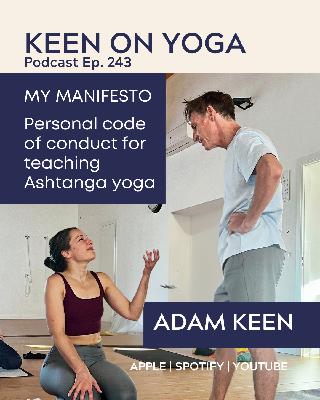

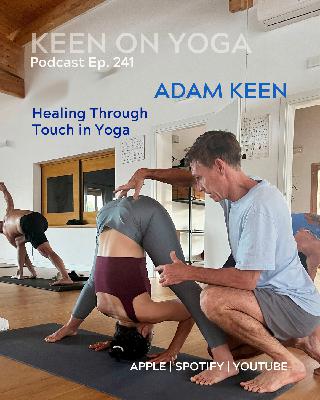



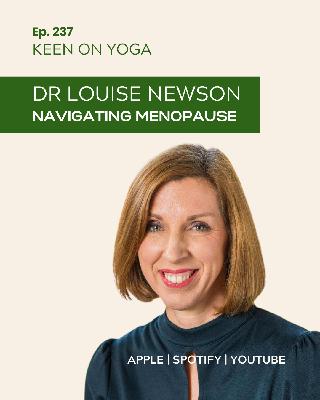

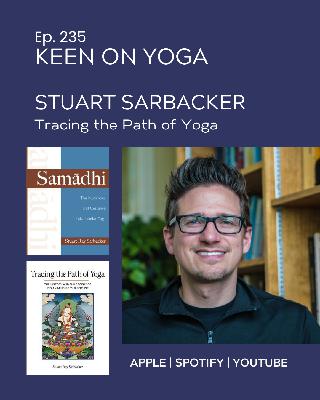
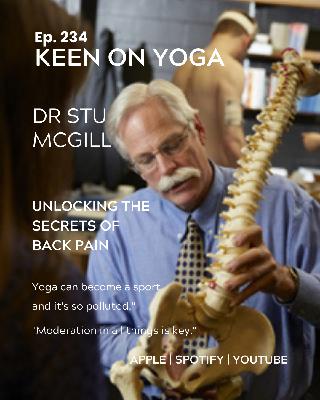

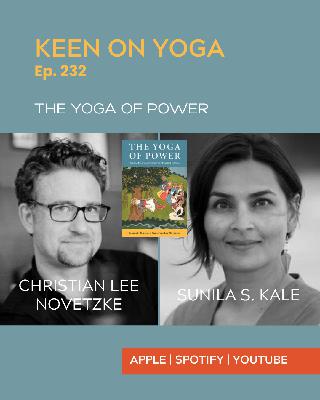
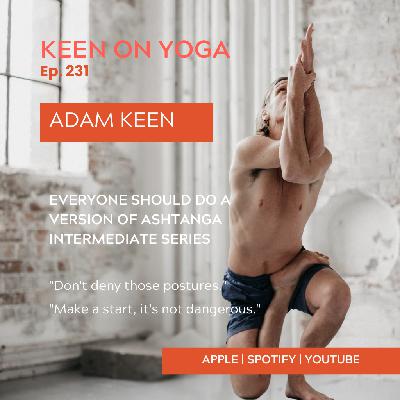

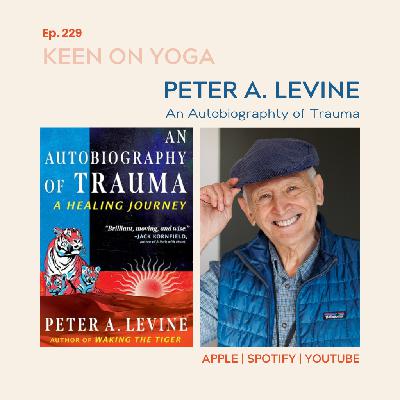

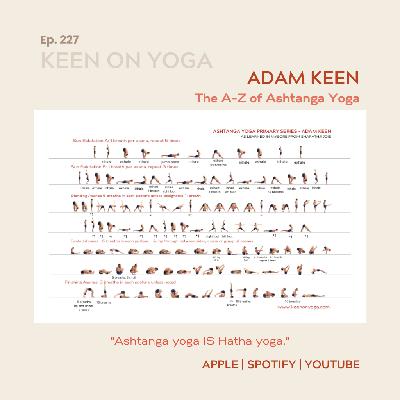
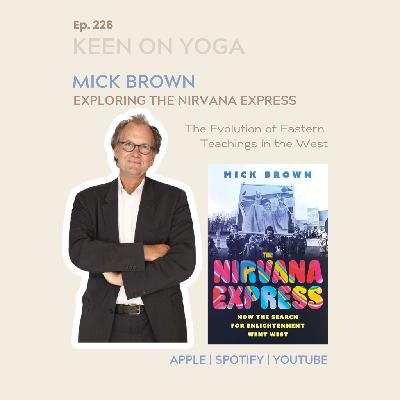
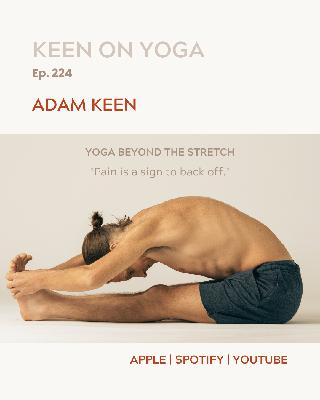




Dearrr u talked a alot! more than ur guest! u did not allow Zoë to speak!